How can companies benefit from ChatGPT? There's something for everyone. IT, of course, but also marketing, communications, finance, HR... A godsend for managers looking to complete their projects. Here are a few uses for AI, some of them surprising, as our expert Cédric Vasseur reveals.
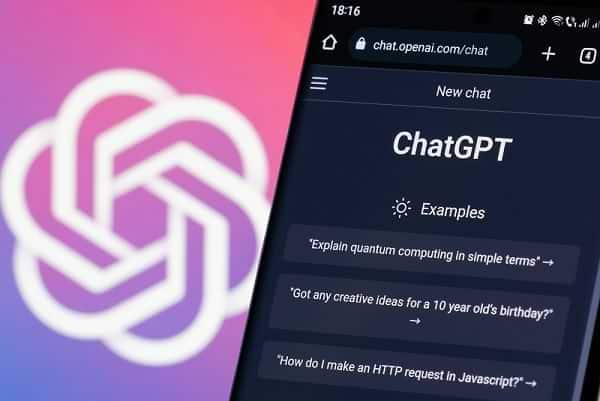
An employee who is an expert at everything, who works 100 times faster than others, 24 hours a day, without ever getting tired and who, what's more, is free in its basic version? To say that ChatGPT is seen by many as a revolution in the world of work would be an understatement. And even beyond.
So much so that some, like Bill Gates, claim that this artificial intelligence is as revolutionary as the mobile phone or the Internet!
According to studies carried out by Goldman Sachs and the University of Pennsylvania, ChatGPT would have an impact on 75 to 80 % jobs worldwide. It therefore has the potential to replace up to 300 million jobs, starting with white-collar workers, particularly managers.
Beyond the tests that anyone can do for free with ChatGPT, what is this AI really worth in a professional context? What tasks can it be assigned? Is it really the ideal employee? Is it just a tool, a super assistant, or can it purely replace a colleague?
To answer these questions, let's look briefly at its origins.
ChatGPT, the origins
Available to the public since the end of November 2022, ChatGPT is, a chatbota conversational agent capable of answering any question formulated in text. Since version GPT-4, it also accepts input in the form of text or image files. Its answers are amazing, because they resemble those of a human being, except that it 'thinks' at computer speed.
Its name comes from the contraction of Chat, for conversation, and GPT for Generative Pre-Trained Transformer, a family of language model large (LLM) created by the American company Open AI. An LLM is a type ofmachine learning which uses deep learning (deep learning) to analyse and produce written or spoken texts using a large amount of training data. LLMs are used in a wide range of fields: machine translation, speech recognition, speech synthesis, etc.
Large, because in order to have an answer for everything, ChatGPT relies on a corpus of hundreds of billions of pieces of text (for GPT-4, its latest version), mostly taken from the Internet or books, on which it was pre-trained during its initial learning. The second phase of its learning was supervised by humans.
AI powered by deep learning
Like all other GPT models, Open AI's artificial intelligence uses deep learning to predict the next word in a sentence, similar to the predictive typing used when writing a text message. To do this, it uses statistical analysis and correlation of a huge amount of data. In order to convert this model into chatbotIts designers have integrated a set of thousands of questions and answers. However, to describe it simply as a chatbot would be considerably simplistic. Its advanced capabilities and versatility take it to another level of development.
ChatGPT gives you much more than just answers
ChatGPT is a member of the generative AI family. Unlike other AIs, ChatGPT is able to create original content. Its speciality: creating texts.
What's more, ChatGPT has a huge advantage over search engines: it remembers the exchanges you have with it during the same session. This means you can ask for clarification or corrections to a question you have already asked or to a document you have created, without having to rephrase everything.
So its skills extend far beyond what a search engine or Wikipedia can provide. This Generative AI is able to :
- Create any type of textual document: slogan, tagline, article, press release, report, dissertation, thesis, poetry, music, etc.
- Summarise one or more documents of any size
- Correct the spelling and grammar of any text, improve the document according to your instructions and adopt any writing style (formal, academic, marketing, journalistic, that of Victor Hugo or Steve Jobs...).
- Translate and write in almost any language
- Creating, converting and debugging computer code
- Create functions and macros on demand for Excel, Google Sheets, LibreOffice, etc.
What are the benefits of combining his immense knowledge base with his exceptional language skills?
Let's take a moment to analyse the practical applications of ChatGPT in different business areas to better understand how this technology can be exploited effectively.
For communication and marketing
Writing content
ChatGPT is an extraordinary tool for writing professional documents: reports, social media posts, blog articles, newsletters, PowerPoint presentations, emails, press releases and other types of content to attract and engage your target audience.
The AI can summarise one or more texts, or even complete a text based on an introduction or outline. For example, by providing an introductory text, ChatGPT is able to generate the rest with relevant suggestions, correctly written in French and well structured.
You can specify the number of words, characters or pages the text should contain.

Preparing a brainstorming session
ChatGPT can help generate new and original ideas for marketing campaigns, sales strategies and product design. It suggests slogans and catchy headlines to launch a product or conquer new markets in France and abroad.
Translate documents
What's more, ChatGPT is perfectly multilingual. It speaks hundreds of languages, including languages with ideograms such as Chinese, Japanese and Korean. So there's no need to worry about getting it to translate documents. In our tests, it even outperformed specialist software such as DeepL.
It can easily translate abbreviations, even out of context.

Optimising search engine optimisation (SEO)
ChatGPT can help optimise your website content for search engines by generating meta tags, titles, descriptions and suggesting relevant keywords.
It can extract keywords from web pages or documents. This can help community managersSEO web copywriters, traffic managers and SEO strategy managers.
Analyze customer reviews
By sending ChatGPT all your customers' comments, AI can analyse them and identify trends and opinions across channels (social networks, your website, etc.) so that you can adjust your products and services accordingly, responding proactively to your customers' needs and preferences.
For human resources
Time is running out and you don't know which profile to recruit, how to write an effective job description, job offer or friendly rejection letter? ChatGPT will come to your rescue. Here are a few examples:
- "How do you write an attractive job advert for a full stack developer?"
- "What are the key elements to include in a job description for a project manager?"
- "Write a friendly rejection email or letter for a social media manager position".
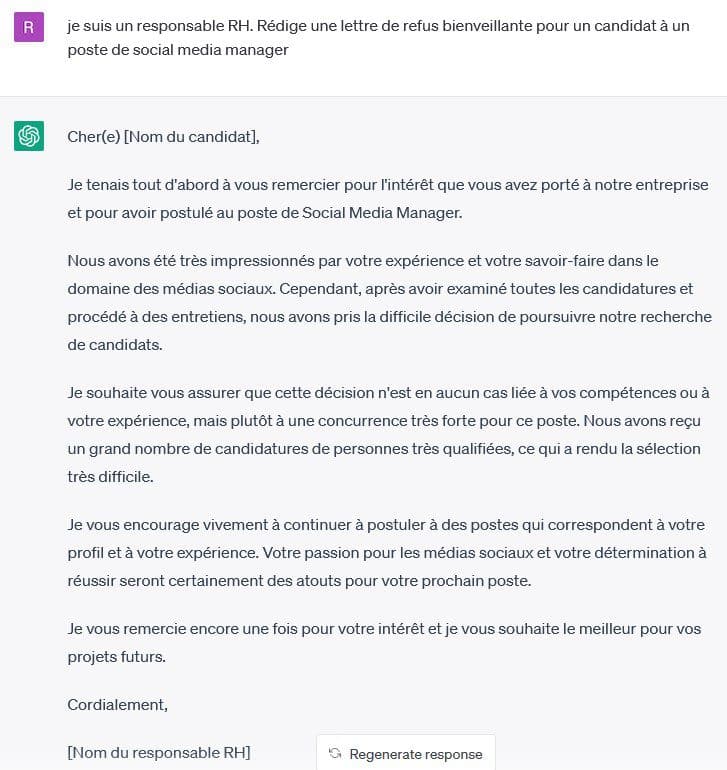
For finance, administrative and legal services
ChatGPT can help to analyse financial data, create reports from a large mass of documents and explore financial simulations. Administrative and legal departments can use it to design and adapt contracts in the same style as those already signed by the company.
For IT services
ChatGPT can be of great service to IS professionals. Here are a few examples:
Technical assistance
ChatGPT becomes virtual assistant to provide first-level technical support and answer users' questions 24/7. It answers questions and guides users through troubleshooting steps to resolve common problems. This reduces the workload on support staff.
Documentation and knowledge base
AI can help create and maintain an up-to-date knowledge base of IT procedures, common problems and troubleshooting solutions. It can also be asked to create training courses and tutorials on the use of software and hardware, to make it easier for new employees to get to grips with the system and to enhance the skills of existing users.
Detection of cyber security threats
ChatGPT can be used to monitor and analyse security logs to detect potential threats and help security teams take preventive action.
Breakdown and maintenance forecasting
In the same way that it analyses security logs, ChatGPT is capable of analysing historical fault data in real time in order to predict potential faults and optimise IT system maintenance planning.
Code creation, optimisation and revision
As we saw above, AI is capable of generating code, creating scripts, browser extensions or formulas for Excel or Google Sheets. It will not only help developers to save time, but also anyone in the company who needs to create formulas in Excel.
Gifted in languages, ChatGPT reads and writes the main computer languages. For example, a DevOps engineer could ask it to create a Python script.
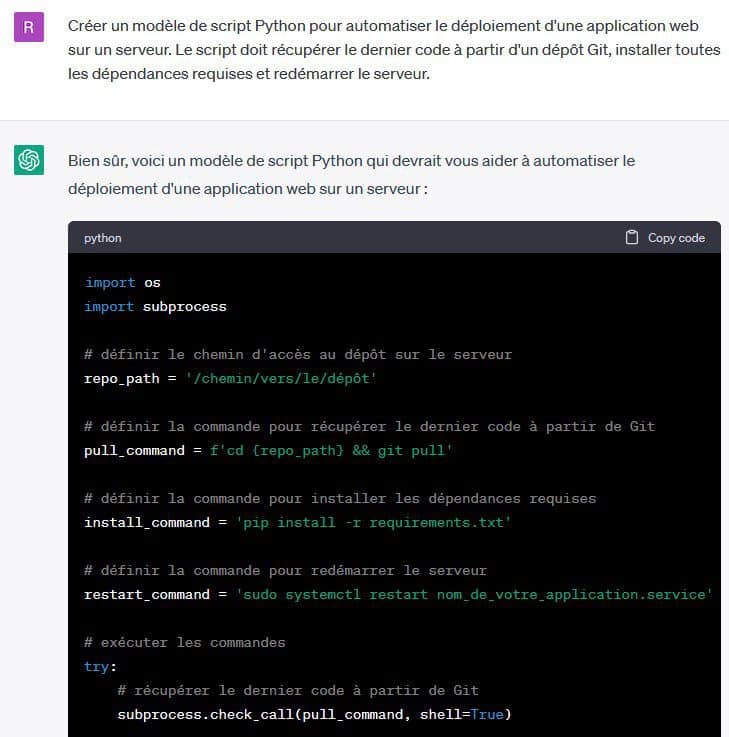
It's up to the engineer to customise the code with the different access paths to the server and the Git repository.
ChatGPT will speed up the creation of websites, scripts and code for developing complex applications. Its debugging and commenting capabilities are impressive. Despite this, it regularly makes errors that can go unnoticed.
For example, when we asked it to create an Excel formula that counts cells in colour, it displayed this answer:
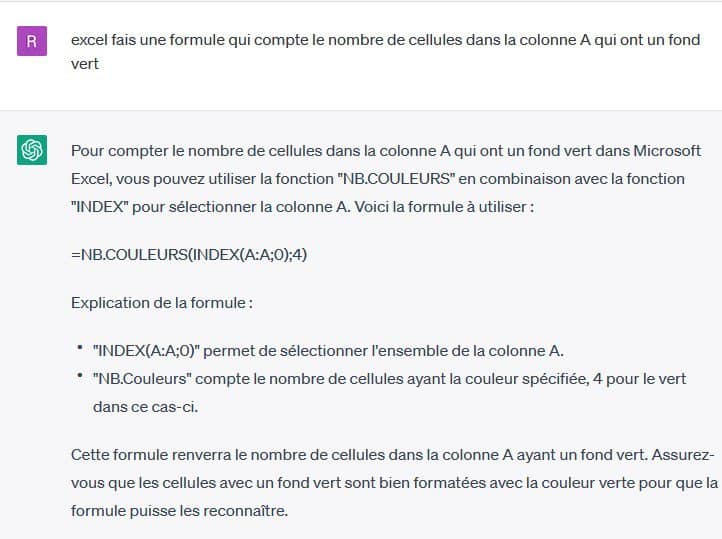
However, this NB.COLOURS function does not exist in Excel. This is an example of a hallucinations ". These are false answers that ChatGPT claims to be correct. These hallucinations can sometimes take a comic turn:
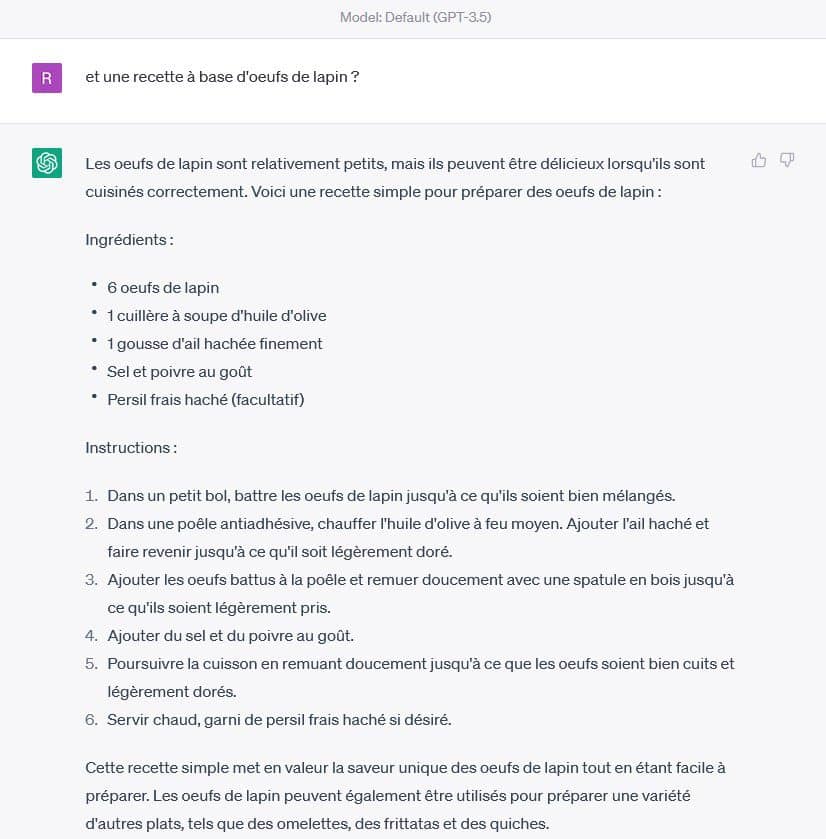
The limits of ChatGPT
ChatGPT is not all-powerful. Here are some of its main limitations:
- His responses tend to be academic and standardised: his default style is rather cold and impersonal, unless he is asked to write in a particular style or tone.
- ChatGPT does not mention its sources, unlike Wikipedia or press articles.
- They can "hallucinate", inventing an answer when they don't have an answer to a question.
- His answers can mix truth and falsehood with perfect consistency.
- He cannot write highly specialised documents in a specific field, such as a complete computer programme.
- Its current version, GPT-4, is not connected to the Internet and its knowledge base does not extend beyond September 2021. It will therefore not be able to answer topical questions or incorporate recent knowledge into its answers.
- ChatGPT does not really understand what it writes. It only works thanks to statistical algorithms.
- 46% of the content of its corpus is in English and its results are heavily biased towards American culture.
- ChatGPT has no ethics or emotions. To compensate for its shortcomings, it adopts a bias neutrality, which aims to nuance its statements as much as possible.
Dazzling progress in just a few months
These flaws are corrected with each new monthly update of the AI model. And ChatGPT has recently started accepting plugins and APIs to open it up to other software and give it access to the Internet. As a major shareholder in Open AI, Microsoft has integrated it into its Bing search engine and plans to graft it onto its Microsoft 365 and Azure cloud services. The ChatGPT adventure and that of its competitors - Google's Bard springs to mind - has only just begun.
Ultimately, ChatGPT is an incredibly powerful tool for businesses, offering a variety of practical applications to help solve problems and increase team efficiency. For the moment, ChatGPT is more of a formidable productivity tool than a competitor, let alone an autonomous collaborator. It still needs professionals to guide it and check its output. And to make full use of it, it is important that employees are trained and familiarised with its capabilities and limitations.


